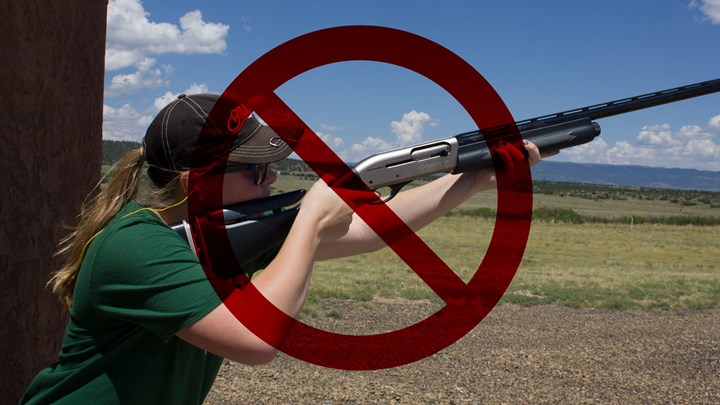
by Brian McCombie - Tuesday, March 28, 2023

In California, an appeal has been filed by the plaintiffs in an NRA-backed lawsuit challenging a state law that has the potential to bring California’s hunting and shooting sports to the brink of extinction.
In 2022, California passed AB 2571. Signed into law by Gov. Gavin Newsom, it essentially made it illegal to market hunting and the shooting sports to California youth. The NRA was among the groups that challenged the law in federal court—in the case captioned Safari Club International v. Bonta—and asked for a preliminary injunction to prohibit the law from taking effect.
According to NRAHLF.org, the injunction was put forth “citing violations of Californians’ constitutional rights under the First, Second, Fifth and Fourteenth amendments.” The plaintiffs in the case are Safari Club International, the U.S. Sportsmen’s Alliance Foundation and the Congressional Sportsmen’s Foundation, all of which actively promote youth firearm safety, the shooting sports and numerous hunting and hunter-backed wildlife conservation programs.
As Michael Jean, Director of the Office of Litigation for the NRA’s Institute for Legislative Action (NRA-ILA), explained at the time the law was initially challenged, “The real problem that AB 2571 poses is that its broad scope and vaguely defined terms are designed to prevent the next generation from participating in hunting and shooting sports. It outlaws content concerning the ‘use’ of a firearm or firearm accessory that a minor may find attractive. Any content promoting or encouraging youth hunting or shooting sports will obviously be covered under the statute and be subject to a fine of up to $25,000 per copy of the content.”
The “broad language” that Jean referred to banned the use of firearms and firearm accessories in all advertisements, magazine articles, flyers, social media promotions and other communications promoting youth shooting sports camps, hunting clinics and other firearm-related activities.
In an apparent concession that the vagueness permeated the statute and gave it the broadest scope possible, the legislature amended the law in August 2022, weeks after the NRA’s lawsuit was filed. The statute now exempts hunter-education advertisements and removed the ban on content that merely concerns the “use” of a firearm.
But those amendments don’t go far enough because the statute still prohibits content that “may” be attractive to minors. “The law still prohibits content that is protected by the First Amendment,” Jean said. “A manufacturer cannot run an advertisement showing a father and son hunting in the field together because it has a minor in it and, therefore, may be attractive to minors, despite the fact that the ad is just as—if not more—attractive to all the fathers out there who want to teach their kids to hunt.”
Unfortunately, a federal judge sitting on the Central District of California denied that preliminary injunction in a separate case captioned Junior Sports Magazine v. Bonta in October 2022. And another federal judge in the Eastern District of California denied the preliminary injunction sought in the NRA-backed Safari Club International case. As a result, all members of the firearm industry had to suspend any marketing or promotions that might be construed as “appealing” to California youth.
Now the denial of the preliminary injunction has been appealed to the Ninth Circuit Court of Appeals.
Ironically, California’s own Department of Fish and Wildlife (CDFW) launched an R3 (Recruitment, Retention and Reactivation) program to boost the state’s number of people participating in hunting, fishing and the shooting sports. CDFW’s report on the agency’s R3 plan was published in January 2019. Extremely wide-ranging, the plan included many R3 stakeholder groups in the state and incorporated directives to improve hunter education, encourage mentored hunting opportunities and boost access to and awareness of public hunting lands within California. It even recommended numerous improvements to public shooting ranges.
A large focus of the R3 plan concerned the aggressive marketing of these and other R3 efforts via social media, brochures and newspaper and magazine articles, and through creating and sharing a host of YouTube-type videos.
As the document noted in its “Conclusion” section, “The strategy outlined in this document is not the destination but a journey for a continuous effort that should take place over many decades. The R3 strategy will be continuously evaluated and adapted to fit the current needs of ensuring sustainable resource use for hunting, fishing and the shooting sports under current R3 science.”
However, recruiting new people to hunting and shooting sports over a period of “decades” just got much more difficult because of the content banned by AB 2571.
With a decline in hunting and the shooting sports that AB 2571 would surely help to create, California would potentially lose millions of dollars in wildlife conservation funding, too.
NRAHLF.org will continue to monitor this challenge to AB 2571.
About the Author
NRAHLF.org contributor Brian McCombie is a field editor for the NRA’s American Hunter and writes about firearms and gear for the NRA’s Shooting Illustrated. He is a member of the National Rifle Association and the National Shooting Sports Foundation. Brian likes hunting hogs, shooting 1911s chambered in 10mm and .45 ACP, watching the Chicago Bears and relaxing with his two cats, Peanut Morgan and MikaBear.
E-mail your comments/questions about this site to:
[email protected]
Proudly supported by The NRA Foundation and Friends of NRA fundraising.
